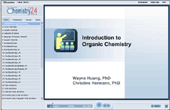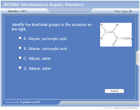Introduction to Organic Chemistry
| Topic Review on "Title": |
Organic Chemistry
Carbon is the basis for all living things. Organic chemistry is the chemistry of carbon compounds. Organic compounds are used for food, medicine, fuel, plastics, and clothing. Learn the proper vocabulary and abbreviations. Learn how to drawn structures correctly.
Functional Groups
An alkane contains carbon-carbon single bonds. An alkene contains a carbon-carbon double bond. An alkyne contains a carbon-carbon triple bond. An aromatic compound contains a six membered ring with alternating double and single bonds. R, or alkyl, is an alkane that has lost a hydrogen. X is fluorine, chlorine, bromine, or iodine. An alkyl halide (haloalkane) contains an alkyl group and an halogen. An alcohol consists of an alkyl group and an hydroxy group (OH). An ether contains an oxygen, with an R group on both sides. A thiol contains a sulfur, with a R group on one side and an hydrogen on the other side of the sulfur. A sulfide has a sulfur with a R group on both sides. An aldehyde contains a hydrogen attached to the carbon of a C=O. An hydrogen or R group is on the other side. A ketone contains two R groups attached to the carbon of the C=O. An acid halide contains a halogen attached to the carbon of a C=O. A hydrogen or R group is attached on the other side of the carbon. A carboxylic acid contains a C=O with a H or alkyl group and an OH attached to the carbon of the C=O. An ester has a H or alkyl group and an OR (alkoxy) group attached to the carbon of the C=O. An anhydride contains two C=O groups separated by an oxygen. R and / or H groups are attached to the carbon of the C=O. Amines contain at least one alkyl group attached to a nitrogen. The other positions are hydrogens or alkyl groups. Amides have a nitrogen attached to a carbon of the C=O. The other positions are hydrogens or alkyl groups. A nitrile has an alkyl group attached to the carbon of the C=N.
Acids and Bases
An Arrhenius acid is a substance that dissociates to give H3O+ (hydronium ion). An Arrhenius base is a substance that dissociates to give BOH (hydroxide ion). A Bronsted-Lowry acid is a substance that can donate a H+. A Bronsted-Lowry base is a substance that can accept a H+. A conjugate acid is the acid that results from the Bronsted-Lowry base gaining a H+. A conjugate base is the base that results from the Bronsted-Lowry acid losing a H+. An amphoteric compound is a compound that reacts as an acid or a base. A Lewis acid is a substance that can accept electron pairs to form new bonds. A Lewis base is a substance that can donate electron pairs to form new bonds.
Electron Pushing
Locate the electrons on the more electronegative atoms. Identify the most electronegative atom and the least electronegative atom in a bond. A mechanism is a step-by-step explanation of what happens in a chemical reaction. The flow of electrons in a mechanism is from the most electronegative atom to the least electronegative atom. The nucleophile donates the electrons in a mechanism. The electrophile accepts the electrons in a mechanism. Resonance structures are two or more equivalent structures for the same arrangements of atoms, the only difference is the location of the electrons. Delocalization are electrons that are distributed among more than two atoms that are bonded together.
|
| Rapid Study Kit for "Title": |
| Flash Movie |
Flash Game |
Flash Card |
| Core Concept Tutorial |
Problem Solving Drill |
Review Cheat Sheet |
 |
 |
 |
|
| "Title" Tutorial Summary : |
The background information for organic chemistry includes the chemistry of carbon and the language of organic chemistry. The structure of the functional groups are described. The functional groups are alkane, alkene, alkyne, aromatic, alkyl halide, alcohol, ether, thiol, sulfide, aldehyde, ketone, acid halide, carboxylic acid, ester, anhydride, amine, amide, and nitrile. The three types of acids and bases are Arrhenius, Bronsted-Lowry, and Lewis. In organic chemistry, it is important to know about electrons, mechanisms, resonance, and delocalization. To learn organic chemistry, a student must learn the terminology, functional groups, nomenclature, electrons, and mechanisms. Repetition of the concepts is important. Ask for help when needed.
|
| Tutorial Features: |
This tutorial provides the comprehensive coverage of the chapter with easy introduction and simple illustration. It features:
- Concept map showing interconnections of new concepts in this tutorial and those previously introduced.
- Definition slides introduce terms as they are needed.
- Compare and contrast of structures and terminology.
- Visual representation of concepts.
- Use of colors to emphasis points.
- Functional groups are illustrated through drawings.
- Compare and contrast of acids and bases.
- Examples worked out step-by-step throughout the tutorial.
- A concise summary is given at the conclusion of the tutorial.
- Learn how to understand organic chemistry.
|
| "Title" Topic List: |
Organic Chemistry
- Chemistry of Carbon
- Language of Organic Chemistry
Functional Groups
- Alkane
- Alkene
- Alkyne
- Aromatic
- Alkyl Halide
- Alcohol
- Ether
- Thiol
- Sulfide
- Aldehyde
- Ketone
- Acid Halide
- Carboxylic Acid
- Ester
- Anhydride
- Amine
- Amide
- Nitrile
Acids and Bases
- Arrhenius
- Bronsted-Lowry
- Lewis
Electron Pushing
- Electrons
- Mechanisms
- Resonance
- Delocalization
How to Study Organic Chemistry
- Terminology
- Functional Groups
- Nomenclature
- Electrons
- Mechanisms
- Repetition
- Ask for Help
|
See all 24 lessons in college chemistry, including concept tutorials, problem drills and cheat sheets:
Teach Yourself Organic Chemistry Visually in 24 Hours |



